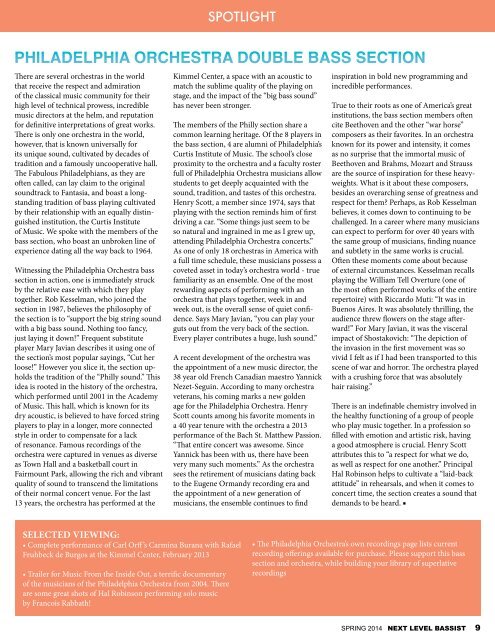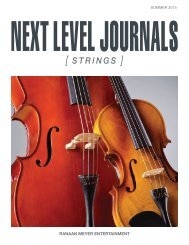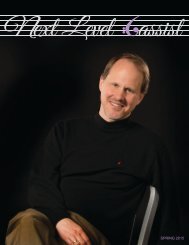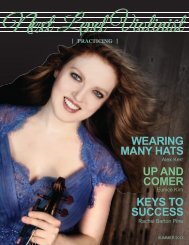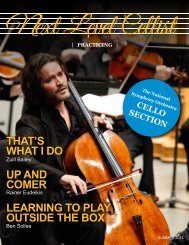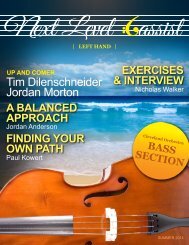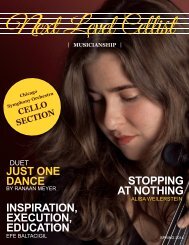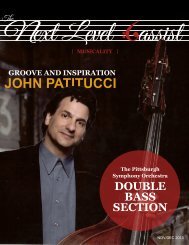Next Level Bassist Teaching and Inspiration
You also want an ePaper? Increase the reach of your titles
YUMPU automatically turns print PDFs into web optimized ePapers that Google loves.
SPOTLIGHT<br />
PHILADELPHIA ORCHESTRA DOUBLE BASS SECTION<br />
There are several orchestras in the world<br />
that receive the respect <strong>and</strong> admiration<br />
of the classical music community for their<br />
high level of technical prowess, incredible<br />
music directors at the helm, <strong>and</strong> reputation<br />
for definitive interpretations of great works.<br />
There is only one orchestra in the world,<br />
however, that is known universally for<br />
its unique sound, cultivated by decades of<br />
tradition <strong>and</strong> a famously uncooperative hall.<br />
The Fabulous Philadelphians, as they are<br />
often called, can lay claim to the original<br />
soundtrack to Fantasia, <strong>and</strong> boast a longst<strong>and</strong>ing<br />
tradition of bass playing cultivated<br />
by their relationship with an equally distinguished<br />
institution, the Curtis Institute<br />
of Music. We spoke with the members of the<br />
bass section, who boast an unbroken line of<br />
experience dating all the way back to 1964.<br />
Witnessing the Philadelphia Orchestra bass<br />
section in action, one is immediately struck<br />
by the relative ease with which they play<br />
together. Rob Kesselman, who joined the<br />
section in 1987, believes the philosophy of<br />
the section is to “support the big string sound<br />
with a big bass sound. Nothing too fancy,<br />
just laying it down!” Frequent substitute<br />
player Mary Javian describes it using one of<br />
the section’s most popular sayings, “Cut her<br />
loose!” However you slice it, the section upholds<br />
the tradition of the “Philly sound.” This<br />
idea is rooted in the history of the orchestra,<br />
which performed until 2001 in the Academy<br />
of Music. This hall, which is known for its<br />
dry acoustic, is believed to have forced string<br />
players to play in a longer, more connected<br />
style in order to compensate for a lack<br />
of resonance. Famous recordings of the<br />
orchestra were captured in venues as diverse<br />
as Town Hall <strong>and</strong> a basketball court in<br />
Fairmount Park, allowing the rich <strong>and</strong> vibrant<br />
quality of sound to transcend the limitations<br />
of their normal concert venue. For the last<br />
13 years, the orchestra has performed at the<br />
Kimmel Center, a space with an acoustic to<br />
match the sublime quality of the playing on<br />
stage, <strong>and</strong> the impact of the “big bass sound”<br />
has never been stronger.<br />
The members of the Philly section share a<br />
common learning heritage. Of the 8 players in<br />
the bass section, 4 are alumni of Philadelphia’s<br />
Curtis Institute of Music. The school’s close<br />
proximity to the orchestra <strong>and</strong> a faculty roster<br />
full of Philadelphia Orchestra musicians allow<br />
students to get deeply acquainted with the<br />
sound, tradition, <strong>and</strong> tastes of this orchestra.<br />
Henry Scott, a member since 1974, says that<br />
playing with the section reminds him of first<br />
driving a car. “Some things just seem to be<br />
so natural <strong>and</strong> ingrained in me as I grew up,<br />
attending Philadelphia Orchestra concerts.”<br />
As one of only 18 orchestras in America with<br />
a full time schedule, these musicians possess a<br />
coveted asset in today’s orchestra world - true<br />
familiarity as an ensemble. One of the most<br />
rewarding aspects of performing with an<br />
orchestra that plays together, week in <strong>and</strong><br />
week out, is the overall sense of quiet confidence.<br />
Says Mary Javian, “you can play your<br />
guts out from the very back of the section.<br />
Every player contributes a huge, lush sound.”<br />
A recent development of the orchestra was<br />
the appointment of a new music director, the<br />
38 year old French Canadian maestro Yannick<br />
Nezet-Seguin. According to many orchestra<br />
veterans, his coming marks a new golden<br />
age for the Philadelphia Orchestra. Henry<br />
Scott counts among his favorite moments in<br />
a 40 year tenure with the orchestra a 2013<br />
performance of the Bach St. Matthew Passion.<br />
“That entire concert was awesome. Since<br />
Yannick has been with us, there have been<br />
very many such moments.” As the orchestra<br />
sees the retirement of musicians dating back<br />
to the Eugene Orm<strong>and</strong>y recording era <strong>and</strong><br />
the appointment of a new generation of<br />
musicians, the ensemble continues to find<br />
inspiration in bold new programming <strong>and</strong><br />
incredible performances.<br />
True to their roots as one of America’s great<br />
institutions, the bass section members often<br />
cite Beethoven <strong>and</strong> the other “war horse”<br />
composers as their favorites. In an orchestra<br />
known for its power <strong>and</strong> intensity, it comes<br />
as no surprise that the immortal music of<br />
Beethoven <strong>and</strong> Brahms, Mozart <strong>and</strong> Strauss<br />
are the source of inspiration for these heavyweights.<br />
What is it about these composers,<br />
besides an overarching sense of greatness <strong>and</strong><br />
respect for them? Perhaps, as Rob Kesselman<br />
believes, it comes down to continuing to be<br />
challenged. In a career where many musicians<br />
can expect to perform for over 40 years with<br />
the same group of musicians, finding nuance<br />
<strong>and</strong> subtlety in the same works is crucial.<br />
Often these moments come about because<br />
of external circumstances. Kesselman recalls<br />
playing the William Tell Overture (one of<br />
the most often performed works of the entire<br />
repertoire) with Riccardo Muti: “It was in<br />
Buenos Aires. It was absolutely thrilling, the<br />
audience threw flowers on the stage afterward!”<br />
For Mary Javian, it was the visceral<br />
impact of Shostakovich: “The depiction of<br />
the invasion in the first movement was so<br />
vivid I felt as if I had been transported to this<br />
scene of war <strong>and</strong> horror. The orchestra played<br />
with a crushing force that was absolutely<br />
hair raising.”<br />
There is an indefinable chemistry involved in<br />
the healthy functioning of a group of people<br />
who play music together. In a profession so<br />
filled with emotion <strong>and</strong> artistic risk, having<br />
a good atmosphere is crucial. Henry Scott<br />
attributes this to “a respect for what we do,<br />
as well as respect for one another.” Principal<br />
Hal Robinson helps to cultivate a “laid-back<br />
attitude” in rehearsals, <strong>and</strong> when it comes to<br />
concert time, the section creates a sound that<br />
dem<strong>and</strong>s to be heard. ■<br />
SELECTED VIEWING:<br />
• Complete performance of Carl Orff ’s Carmina Burana with Rafael<br />
Fruhbeck de Burgos at the Kimmel Center, February 2013<br />
• Trailer for Music From the Inside Out, a terrific documentary<br />
of the musicians of the Philadelphia Orchestra from 2004. There<br />
are some great shots of Hal Robinson performing solo music<br />
by Francois Rabbath!<br />
• The Philadelphia Orchestra’s own recordings page lists current<br />
recording offerings available for purchase. Please support this bass<br />
section <strong>and</strong> orchestra, while building your library of superlative<br />
recordings<br />
SPRING 2014 NEXT LEVEL BASSIST<br />
9


